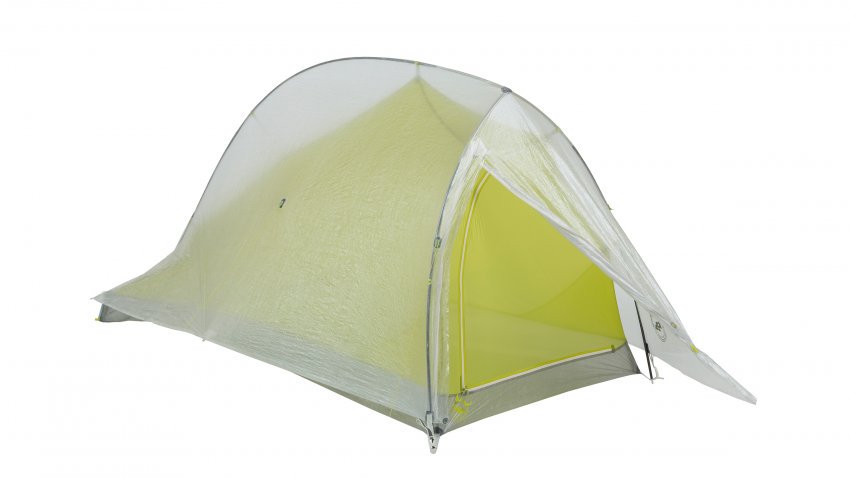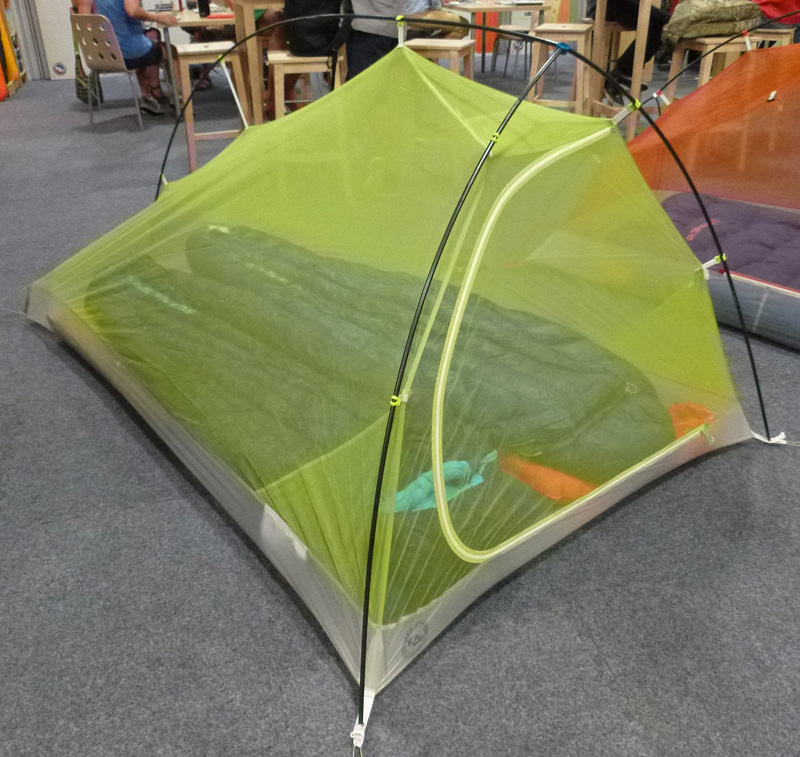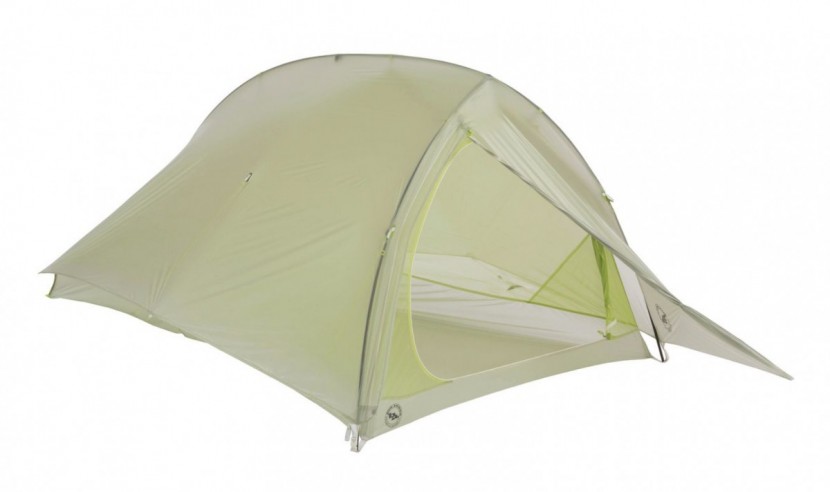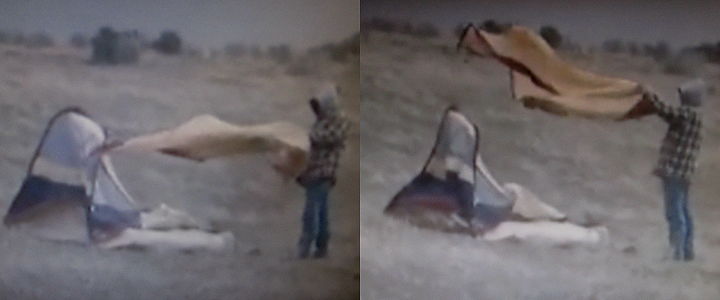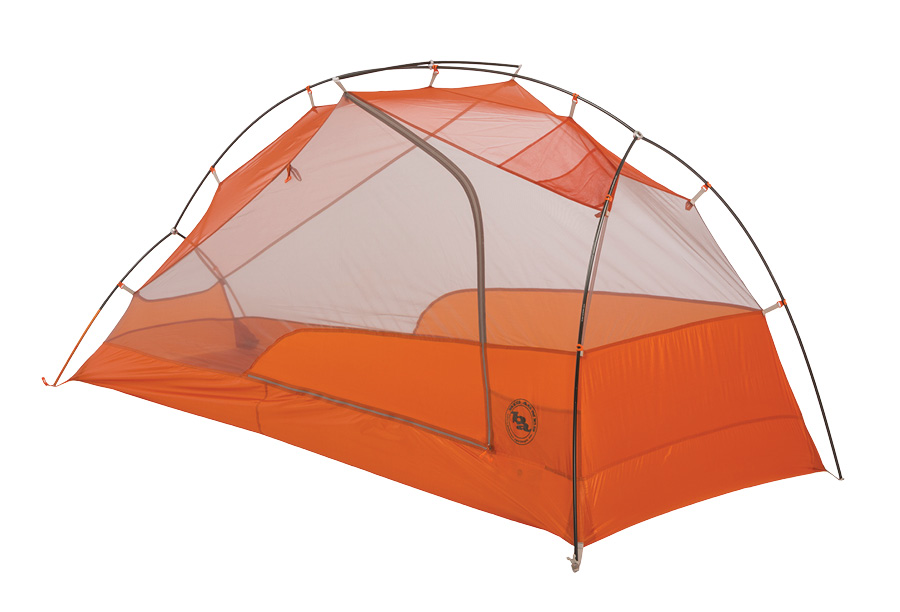Topic
Big Agnes Fly Creek HV1 Carbon with Dyneema Tent
Forum Posting
A Membership is required to post in the forums. Login or become a member to post in the member forums!
Home › Forums › Gear Forums › Gear (General) › Big Agnes Fly Creek HV1 Carbon with Dyneema Tent
- This topic has 80 replies, 27 voices, and was last updated 6 years, 7 months ago by
 Richie S.
Richie S.
-
AuthorPosts
-
Jul 25, 2018 at 11:33 pm #3548404
“Also, the shadow in the photo makes me wonder if it is a hammock cover suspended with one cord, hiding under a Fly Creek canopy. If so they deserve the grand award for chutzpah”.

Not sure what you meant there , but this is the inner of the Platinum version :

not identical but very similar.
And the full Platinum tent for comparison :
 Jul 25, 2018 at 11:53 pm #3548405
Jul 25, 2018 at 11:53 pm #3548405Carbon fibre and Cuben fabric – it MUST be the ultimate …
Pity it is still just a pop-up.
There’s a video on YouTube (somewhere) of a guy trying to get his pop-up erected in a storm. It was kinda hilarious. These are two stills from that video:
You can figure out the rest for yourselves. I don’t think the video ever showed him succeeding. Come in suckers.
Cheers
Jul 26, 2018 at 12:23 am #3548410My guess is there is a market for this. I prefer a tent that uses trekking poles, but there a lot of people who love free-standing tents, and this one is ridiculously light. Each BA model has its own strengths and weaknesses, but they are a solid brand — I know a lot of people who use them. Reaching the arbitrary number of an even one pound is like having a car that gets 50 MPG — not really that important, but it does make you feel pretty cool. Yes, it will be tossed around in the wind, but if you camp in mile weather, it will keep the rain and bugs at bay. Oh, and unlike a lot of very good, very light tents, you can buy it at REI, which has a very liberal return policy. Not as easy as it used to be, but if you buy it, and the poles break during a storm, at the very least you have a good shot at getting new poles. Just being able to use your dividend on a tent like this means that it will sell. Of course most people don’t have a dividend this big, but for a while I had an REI Visa, and struggled trying to find enough stuff to buy (I persevered :)).
$750 is a lot of money, but a quick check at what REI offers shows that it is by no means the most expensive. All the other tents are bigger or more storm worthy (4 season tents), but so what? There are plenty of one person three season tents that go for around $500. Would someone pay an extra $250, just to save a few ounces? You bet your ass they will. Holy cow, look at how much people pay for cars. I can walk down the street and point out car after car that are nowhere near the cheapest model that manufacturer makes. A Honda Civic is not considered extravagant (let alone an Accord), even though you could get by just fine with a Fit. Why should a vehicle costing thousands more be considered “normal”, but spending a few hundred (heck, the price of a few nights at a motel) be considered crazy. Or how about skis (both backcountry and resort)? It doesn’t take much research to see that people are willing to pay hundreds and hundreds more just for something they think will be a little bit better. This seems very similar, even though I don’t think it makes sense for me.
Jul 26, 2018 at 1:37 am #3548413So many grumpy people. BA pushes things forward in the ul category. Their tents have never appealed to me an I’m not going to be getting this one. But it may push another manufacturer to make something i do like.
For a fair-weather camper in a place with reasonably predictable conditions this could be the perfect tent.
Jul 26, 2018 at 1:54 am #3548415Grumpy???
Or gleefully dissecting?Cheers
Jul 26, 2018 at 2:18 am #3548416Growing up in the UK where the risk of hypothermia was drilled into me by teachers and from personal experience I used to shake my head at some of the lightweight gear being used in the US – but it works for people spending weeks and months on the hills here.
Jul 26, 2018 at 4:00 am #3548425Franco,
The projected tent appears to be a one person, altho no specs are offered. Your photo of the inner tent appears to be a 2 person – much larger.Roger,
It is not a true self-supporting tent, as the two of the four corners of the main tent (not including the ‘vestibule’) are supported only by stakes. In Franco’s photo, the sleeping bags have the heads at the entrance. If you wanted your head at the rear, you could suffocate with the inner plastered to your head. That is the result of using only stakes to support the rear corners. With poles rising from the rear corners, there would be a little bit of vertical space. With a tent so short, however, it would still be cramped even with poles rising at all four corners. I’ll hold on the merits of self-supporting tents until we have a much better example to discuss.
PS – Is it possible you could find a link to the YouTube video. Nothing fancy, just a link to scan and paste in a browser. Would love to see the whole thing. Thanks.Jul 26, 2018 at 4:15 am #3548431When I was hiking the PCT I knew two folks sharing the FC UL1. It was amazing how they crammed in there – even sharing a single 20″ wide pad.
Jul 26, 2018 at 7:05 am #3548440Franco,
The projected tent appears to be a one person, altho no specs are offered. Your photo of the inner tent appears to be a 2 person – much larger.OK, it doesn’t to me but I still don’t understand how that has anything to do with your comment :
makes me wonder if it is a hammock cover suspended with one cord,To be clear, the inner of that DCF version looks to me very similar to the inner of the other Fly Creek versions and nothing like a hammock cover , whatever that is . (a tarp ?)
Jul 26, 2018 at 9:25 am #3548445Hi Sam
Took a bit of hunting, but it is the 1st one in this list:
Trying to pitch a pop-up in a wind storm

Flying tents at folk festival

Great Mell Fell – failed Atko pitching

Tent being destroyed in Scottish storm

Tent dies in storm

Guy carried away while pitching tent

Cheers
Jul 26, 2018 at 11:48 am #3548448At 8 oz more (in silnylon), the BA Copper Spur HV1 is infinitely better than the Fly Creek HV1. It’s side entry and it has a far superior frame with 4 points of ground contact. Way more solid and stable. I wish BA would have gone DCF with the Copper Spur instead of the Fly Creek, but I guess they wanted to end up with the lowest possible number they could come up with.
I’m not sure how well carbon fiber poles would hold up to the CS design though. By the way, the Fly Creek is NOT a freestanding tent. It’s semi-freestanding at best.
 Jul 26, 2018 at 11:56 am #3548451
Jul 26, 2018 at 11:56 am #3548451Section Hiker’s post for today from the OR show has pics and prices of several new BA Carbon models coming out. The Tiger Wall 2 Carbon is a side entry shelter, but at $1000 I shant be “upgrading” any time soon.
Jul 26, 2018 at 12:20 pm #3548458Our backpacking club owns several BA Copper Spur UL2 tents, the version just before the current “HV” version was released. Our paying club members can borrow gear for free. Anyways, I’m told by our equipment manager that our two BA Copper Spurs are by far the most requested tents.
I would have to agree that as far as free standing lightweight tents go, they are pretty darn good, and much nicer than those Fly Creeks. So good in fact, that I recently purchased a Copper Spur UL3 HV for my daughter to use with her husband and 6 year old son.
Jul 26, 2018 at 12:33 pm #3548461Hopefully it’s just a matter of time before we have more design options available as I stated in a previous post. I’m all for roomier, if not at least more open spaces that the Zpacks designs lack. The Duplex is plenty big enough footprint wise, I’d just like steeper sidewalls and better clearances. Hopefully others get on board as well and the prices start to come down or this inspires zpacks or others to push their designs. I imagine that would just increase their prices too though. I think it’s good news, but we shall see how it all plays out.
Jul 26, 2018 at 5:12 pm #3548487My guess is there is a market for this.
Ross,
Your entire post is right on.
I see a lot of zPacks Duplexes in the back country. Joe is obviously gaining market share in a crowded market, so BA’s foray into cuben isn’t just for brand recognition. The price point isn’t out of line as a $600 Duplex is sold directly from the manufacturer without a “middle man.” The BA offerings “look like” a modern tent to the younger crowd, whereas the A-frame Duplex looks like your grandfather’s shelter. The BA is modular. I think it will sell well.
Jul 27, 2018 at 3:13 am #3548551Roger,
Thank you so much. I’m speechless.Jul 27, 2018 at 3:19 am #3548554Franco,
Separate paragraphs, different issues. As for “hammock cover,” will stand by the comment, although I get what you mean about no change in the shape of the inners (except 1 vs 2 person).Jul 27, 2018 at 3:37 am #3548555Roger, I particularly liked the plaintive “visit Scotland” postscript.
Jul 27, 2018 at 4:22 am #3548559Hi Roger,
Regret to advise that the demise of my speech was greatly exaggerated.
Great videos, and they all seemed to be having fun, which is often not the case in such open terrain. But now I see why wind recorded on the Australian coast was greater than the highest on Mt. Washington in NH.In addition to the Akto, you were good enough to include failure of at least one tent with double pole crossings, the kind that interest me. The first thought was that you must need the supporting side-guys on your tunnels to keep the poles from deforming and flying askew just like the ones in the videos. So the issue becomes how to get the side supports in place no later than the pitching of the tunnel structure. Dan Durston’s tent while not a tunnel has an interesting approach to this, which I’ll hold on for now. For your tunnels, I suppose you would have to have the side guys in place and tightened just the right amount, before the tent is erected by pulling out and securing the two points of the front vestibule. I get that you put in your stakes first.
I think you could have a similar result with a double-cross pole tent by staking the front and rear vestibules just the right distances from each other before raising the dome by seating two of the pole ends on one side.
You raised another issue, pitching an inner without swamping the inside of the tent before putting on the outer, as must be done with most of the American self-supported tents (Hubbas etc.) And that assumes you can even get the outer securely attached in the wind. Even on the Akto in your clip, the outer would not hold still enough to secure it, even with the inner already attached inside. Could it be that the outers, or flies, were not sufficiently secured to the tents and to the ground before attempting to tighten them up and fully erect the tent?
Indeed, I think many of the pitches on the clips failed for that reason. And suggested in another thread that the fly on a double cross pole tent should be attached to the peaks and perhaps to other points before the pitch. As for the swamping, I also suggested that the vestibules be attached to the inner, not the outer fly, and that the inner be made of very high DWR but very breathable sub 1 oz nylon in order to keep that blowing rain out during the pitch and before the fly is fully secured. I realize that the proof of the pudding is in the completion and testing. But this will take some time with the pressure of other commitments and plans. Maybe next winter will see some substantial progress.
Jul 27, 2018 at 6:53 am #3548571Hi Sam
Detailed comments:
You can get high winds on the Oz coastline, but I think the highest ones are on the Main Range near Mt Kosciusko. The reason is that the winds sweep across the continent, get caught in the very large (100s of km) Murray Valley, but that tapers like a funnel and rises. The winds get concentrated as the valley narrows, then they slam into the headwall of the valley – the Main Range. The results up there can be exciting.
you must need the supporting side-guys on your tunnels to keep the poles from deforming and flying askew just like the ones in the videos.
Actually, no, not at all. This is assuming I have not been stupid in pitching the tent, which means that the rear end points into the wind by less than, say, 45 degrees. You see, the rear end vestibule is sort of conical and short and the poles are short. It is very hard for the poles to deform much against the strength of the fabric. The shape of that end vestibule is quite important to the stability of the tent.Implicit in this are two related ideas. The first is that the cord between the corners of the windward end and the stakes is short and does not stretch. Those two corners must not move! The second is that the windward corner stakes are crucial: they must not move either. I use titanium dead man anchors for the corners in the snow. Each of those anchors could hold my weight in packed snow.
Now, what about the other poles? They too are short and are helped by the fabric. I run double guy ropes to all poles on the winter tent, plus I run storm guys on the inside if the weather is really bad. In https://backpackinglight.com/when_things_go_wrong/ I mentioned that I lost some of the side guy ropes when the Spectra frayed against the edges of the Ti angle stakes. I think I lost 6 out of 8. I noticed this around 5:00 in the morning when I could see the tent rattling sideways under the 100 kph wind by 10-20 mm, and I KNEW that was wrong.
The other answer to this question is that I can happily pitch my tunnels in a storm all by my little self. I explain how to do this with a tunnel in https://backpackinglight.com/tunnel_tents_part1/.
Could it be that the outers, or flies, were not sufficiently secured to the tents and to the ground before attempting to tighten them up and fully erect the tent?
Here we simply have a difference in terminology. As far as I am concerned, the ‘tent’ IS the ‘fly’. I am aware that some USA vendors talk about the inner as the ‘tent’, but they are selling pop-ups and therefore simply don’t count. (Biased? Who, me?) The ‘tent’ is what keeps you secure and protects you from the weather; any inner is optional.Finally, any tent which does not have the poles threaded into the fly is strictly a 3-season (if that) Sierra Summer thing. </rant>
Fun Stuff – but less so at 3 am in a storm on a multi-day trip.
CheersJul 28, 2018 at 1:10 am #3548664Hi Roger,
Thanks for the detailed comments. It has been a while since the last time I read and printed your article about when things go wrong, so had forgotten about the frayed spectra. I also was not aware that you use a shorter pole at the rear, as all the pictures I saw showed only several elbowed poles about the same size. I did read your tunnel tent article, and was aware of how you pitch the tent without assistance. However, IMO the links you provided are also very beneficial for other readers whether they choose a factory made tent or make their own.It is not possible to adequately respond to your detailed post without going beyond both the forum and the thread subject, so apologize to all those with concerns about respecting boundaries. However, I did not believe that your last post on this thread could be fairly addressed without considerable detail, and after trying other approaches, feel that this was by far the best place to do it.
I should note that in mountainous areas in the USA, I’ve often seen the wind shift more than 45 degrees, sometimes l80 degrees. But not within the few minutes that it takes to pitch a good tent, so that should not be a pitching problem in all but the most unusual circumstances. The problem arises when the wind shifts after the pitch, and this requires that all four sides of the tent be as resistant to wind as possible.
Since I’m building a ‘side entry’ solo tent, I originally planned to have a one-stake vestibule and entrance, one such vestibule on each side. But after recently exchanging posts with you, I was influenced to make each vestibule have 2 stakes, with each side of the vestibule being a pullout running from one of the two peaks to the ground, as in some of your photos on other recent threads; and the center between the pullouts being for a one-zipper door that will run vertically straight from under the peak vent to just above the ground. Rather than use water resistant zippers that are difficult to operate one-handed, they will be #3 Warmlite zippers that are stronger than the generic #3, weigh only .02 oz more per running foot, and will be protected on the inner and outer by narrow flaps. I’ve found the double flaps keep the water out of vestibules in heavy rain, so long as the front wall of the vestibule is vertical enough to shed water. There is a trade-off between more vertical to keep the rain out, and less vertical to shed winds.
It was suggested on another thread that the tent also have guy loops or D-rings at both peaks to guy out for windy conditions. I agree, and there is nil weight penalty for adding small D-rings at each of the two peaks for additional guying. The elbows at the peaks will be attached to the poles of course, and the rings attached to the elbows to assure firm connections between poles and guy-outs. Since the tent is intended to be protected in all directions, there would be 4 guys, two from each peak, projecting in four directions at 45 degree angles to the floor plan.
Where we part, is on the question of outer pole sleeves supporting all the poles.
This is a bit clumsy for a double cross pole tent, and it intensifies the construction work. More importantly, the original concept of the tent was to bow the double cross poles so they would stretch the walls on the bias to a convex shape and create a partial dome that substantially increases elbow room and combats temp and humidity caused sagging nylon, even with partial PU coating. So the outer tent wall must be of one piece, without sleeves sewn at various angles. This should also improve water resistance if using SUL nylon, like the Rockywoods 7D. Reinforced pole clips can be used on the inner wall to lift it into the partial dome shape.I did look at using polyester to address the sagging issue. The lightest I’ve seen with ripstop threads, mini or regular, is the 20D fabric on Dan Durston’s tent. The better RBTR offering is 1.4 oz/sq/yd. May eventually end up there, but first want to try a 7D ripstop nylon outer and 20D ripstop nylon inner, both being sub one oz. (The latter is now out of stock, but Xtrem-textil now has a ripstop 10D that is also sub one oz and a ripstop nylon Pertex Quantum that is below 1.1 oz/sq/yd) Bottom line, I don’t think polyester fabric light enough to bring the weight of the tent below 2 lb. has the the desired strength and durability. This issue has been discussed at length on the forums, and there are a range of opinions. I think the sagging issue is a serious flaw with conventional nylon tents, and must be addressed somehow, but not at the expense of strength, durability and light weight.
After my last post, realized the difference of the seasons in the US and AU, so note that winter here in NH is only around 4 months away, although many here do not like to dwell on this much in the middle of summer.
Jul 28, 2018 at 3:32 am #3548673Hi Sam
Shorter pole at rear and front – yes, but only slightly. It was done to get the profile, both side on and end on. Later versions have uniform pole lengths.
Wind shift – yeah, I know. We had one camp where the wind came from all 5 directions – the 5th was straight down. Very turbulent, much vortex shedding. Bad place to camp.
Double flaps with zips – actually I only use single flaps over the zips on my tents. I find that is sufficient, while noting that the doors are fairly steep. I find #3 enough.
Extra guy rope attachments – always!
Pole sleeves – I will be obstreperous and argue that a design which does not have all (main) poles in sleeves is not a ‘mountain’ tent. I note you comment about the difficulty with double-cross poles. I can see two solutions for this. The first is to make one external pole sleeve continuous over the top and the other pole sleeve to have a small gap at the top – 10 mm would be sufficient. One could get more fancy I am sure. The second solution is to have one pole sleeve on the outside and the second pole sleeve on the inside. The external pole sleeve would need to be fairly narrow I think.
Humidity and sagging – yes, nylon does relax when wet. My solution for tunnels is to have strong bungee cords at the downwind corners to take up any stretch. Other designs may need slightly different mechanisms. Changing to polyester fabric is a different solution.
Ripstop threads – my tests show that they do almost nothing for silnylon fabric tear strength, but the presence of the ripstop threads measurably and significantly reduces the hydrostatic head the coating can support. The fabric can leak badly along the line of the bigger threads because they make bigger holes. I will argue that a plain weave (ie with no ripstop threads) will always outperform a similar ripstop fabric in HH, with no reduction in strength.
So why ‘ripstop’ in the first place? Marketing pure and simple. It was presented as an enhancement over plain weave and no-one ever thought to test it. Like arch support and pronation control.
Is all this relevant to this thread? I think so, as many newer members may not have read the older BPL articles. Forum subscribers cannot read the BPL articles anyhow.
Cheers
Jul 28, 2018 at 6:50 am #3548692Roger, I’m with you on most points except the ripstop. My experience with the finer ripstops, and the tests done by Richard Nisley at my and other’s requests, show that they do not destroy adequate water resistance. My experience with polyester with no ripstop, is that it has lower tear resistance, and RBTR acknowledges this in test results published on its website. I’ve also found the ripstop will retard the spread of punctures and allow more time for a repair.
Some years ago, as you have pointed out, EPA regs in the US resulted in very poor water resistance from the coatings that were allowed. Of all the silnylon ripstop that you were kind enough to test for me, including your tests on the stuff that you were buying in the US, the only decent result was from a swatch that predated the regs, probably in the first few years after 2000 or even before that. So it was natural that the coatings were leaking at the larger denier fibers because the coatings were inferior. Nowadays, we are fortunate to have Sil/PU coatings that maintain higher water resistance on ripstop fabric, and Richard’s more recent tests have shown that.
Another advantage of using a one piece detachable outer, or fly, is that if the 7D does not perform well, it can be easily swapped out with something slightly heavier. Based on Richard’s tests of the 7D reported on BPL I don’t expect that to happen, but it is always nice to have a backup plan B. For that and other reasons I’ve mentioned, don’t expect me to go cutting up the outer or fly to install pole sleeves. I like your pole sleeve approach to create a bomber 4 season tent, but think for a 3 season solo tent another approach is acceptable to get to lighter weight. I’ve been tenting with non US made 15D nylon in the NE US and Colorado for several years now, in some pretty awful deluges without any leakage, and based on Richard’s test think that the 7D is worth a shot to cut weight even further.
How to pitch the double cross pole tent swiftly in high winds is something that probably cannot be established by discussion. It will take another expensive trip up the Mount Washington auto road on a very windy day with a friend to record the process. I’ll concede that until that is done, the burden of proof rests with me.
Just hope we don’t get arrested for pitching a tent in a restricted area above treeline – so it will have to be a quick pitch and strike for sure.Jul 28, 2018 at 7:15 am #3548694The finer ripstops – since the threads are smaller, the loss of HH should be smaller. Since the coatings have improved as well and the Si/PU coating has been introduced, the game may well have changed. As indeed you noted with your field testing.
Replaceable fly – I fully understand the idea. Since I started off (many years ago) with 70D fabric, the latest weights are very interesting. I would have some hesitation about using 7D for a full-on winter tent, but that does not depend just on the Denier.
For those who may be unfamiliar with the jargon: the 70D and 7D do not refer to the fabric weight or strength; they refer to the fineness of the filaments in the threads. If you go from 10D filaments to 7D ones, the fabric weight may not change. It could be that there are just double the number of filaments in the warp and weft threads. That said, fairly obviously you can weave a lighter fabric using threads made of 7D filaments compared to using 70D ones. The filament Denier is a partial proxy for the fabric weight.
Do you need to cut up the fly to install pole sleeves? I would have thought you could just sew them on. Whether a single layer of fabric could support the sewing on of a pole sleeve (as opposed to using a multi-layer seam): that’s another question!
Thread drift – sigh, I know. I plead guilty.
Cheers
Jul 28, 2018 at 5:30 pm #3548722As many have pointed out on this thread, there are less expensive and much better trekking pole tents that weigh about the same as the Dyneema Fly Creek. However, I believe a lot of us on bapackinglight.com may be looking at things from an ultralight perspective. Fact is, most of the campers/backpackers out there usually want a free-standing (or semi freestanding), full-featured tent with poles, one that sets up pretty easy. So yes, the new DCF Fly Creek may just see good sales after all.
Though I still believe 7d, 10d and 15d silnylon fabrics are the future in ultralight shelters.
-
AuthorPosts
- You must be logged in to reply to this topic.
Forum Posting
A Membership is required to post in the forums. Login or become a member to post in the member forums!
Trail Days Online! 2025 is this week:
Thursday, February 27 through Saturday, March 1 - Registration is Free.
Our Community Posts are Moderated
Backpacking Light community posts are moderated and here to foster helpful and positive discussions about lightweight backpacking. Please be mindful of our values and boundaries and review our Community Guidelines prior to posting.
Get the Newsletter
Gear Research & Discovery Tools
- Browse our curated Gear Shop
- See the latest Gear Deals and Sales
- Our Recommendations
- Search for Gear on Sale with the Gear Finder
- Used Gear Swap
- Member Gear Reviews and BPL Gear Review Articles
- Browse by Gear Type or Brand.

